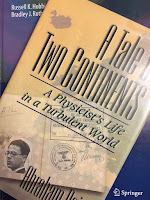My original submission for the special issue was a personal tribute to Art. It began
“Spiral waves have become so popular in Tucson they are even sold in hair styling salons (Figure 1)”
 |
| Figure 1. |
I had to laugh as I read the above quote in a preprint Art Winfree sent me. It was to be the opening sentence of a chapter appearing in a prestigious textbook on cardiac electrophysiology. Unfortunately, the sentence and the picture were deleted before the book's publication, although the picture (Fig. 1) did appear eventually in the second edition of Art’s The Geometry of Biological Time. For me, the quote captures the essence of Art: his humor, his irreverence, and his uncanny ability to find science in the world around him. I only met Art in person once, but we corresponded often by email, exchanging ideas, frustrations, and gossip. Of all the scientists who have influenced my research career, only my PhD advisor John Wikswo had a greater impact than Art Winfree did. In this paper, I describe several instances where my path crossed Art’s as we each attacked related problems in cardiac electrophysiology. In addition, I hope to show that Art made important contributions to what is known as the “bidomain model” of cardiac tissue.Later in the article is one of my favorite passages.
I recall vividly a sunny day in April, soon after my second daughter Katherine was born. I was sitting on a rocking chair in the living room of our house in Kensington, Maryland, holding the sleeping infant in one arm and Art’s book When Time Breaks Down in the other. Outside I could see our dogwood tree in full blossom. As I read page after page, I remember thinking “life doesn’t get any better than this.” The book (and the daughter) changed my life.Unfortunately, the editors of the special issue didn’t like my paper, saying they wanted a more traditional review article. In particular, they objected to my quoting Art’s emails he had sent me. So, I gave the paper a lobotomy and published a harmless but lifeless review. When the issue came out, I found a wonderful article by George Oster about Winfree, full of personal insights and even the text of one of Art’s emails. I wish now I had pushed harder to get my article published in its original form. The best article in the special issue was “Art Winfree, Artist of Science” by his daughter Rachael Winfree.
In the acknowledgments of my paper is the line “I would like to thank Jesse Malouf for his help editing this paper.” Jesse was a student in my honors college course about Pacemakers and Defibrillators. At Oakland University, Honors College has many of the best students in the university, but they are from all backgrounds and often have weak math skills. Jesse was a mathaphobe, but a wonderful writer. On one of my exams I had a mixture of questions, some requiring mathematical analysis and others needing an essay. Jesse skipped the math questions, but to make up for it he not only answered all the essay questions elegantly but also wrote a “bonus essay”. I never had a student hand in a bonus essay before! The next semester, I hired him to help me write the Winfree article. I fear many of his contributions to the original version were not included in the published one.
In the “olden days” the original draft of my Winfree article would be lost forever, or maybe would sit in some file cabinet unseen for decades. But nowadays, you can find anything on the internet (how did we live without it?). I have posted the original submission on my ResearchGate page. You can find it here.








